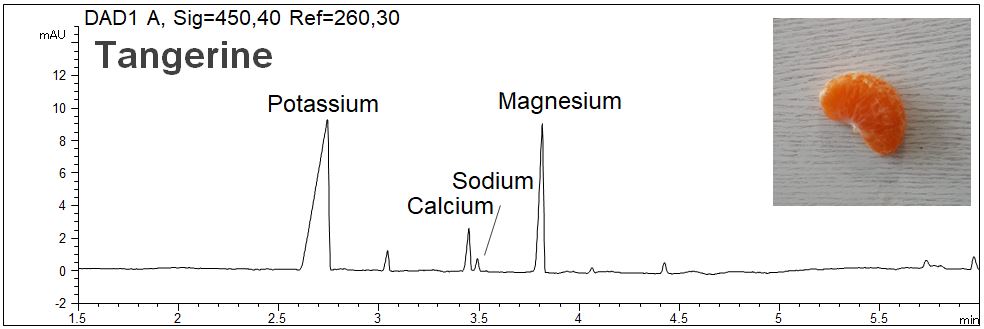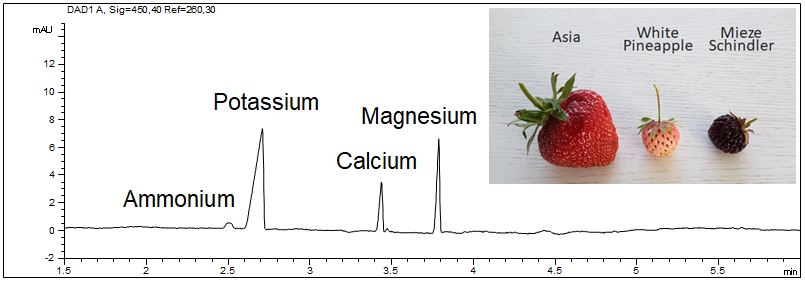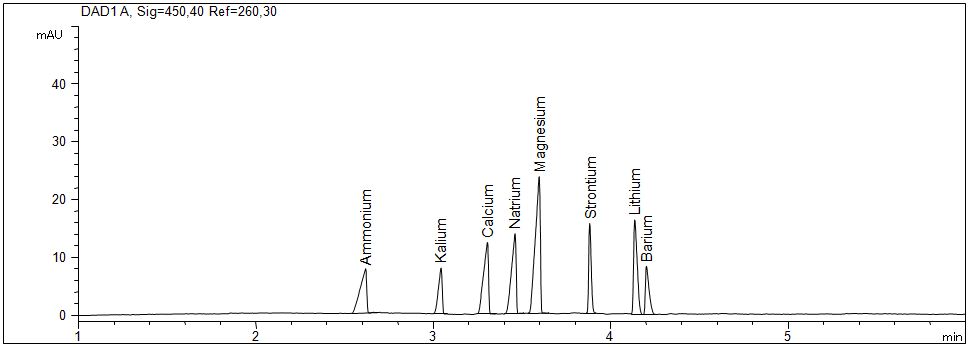Key words: cations, metal ions, Kationen, CE, indirect detection, indirekte Detektion
Inorganic cations can be determined in uncoated capillaries with indirect UV detection. As the EOF migrates in the same direction as the cations short analysis times are possible. For the separation of ammonium and potassium it is necessary to add 18-crown-6 ether, which slows potassium down in relation to ammonium due to a selective complexation of the crown ether and potassium. The UV active co-ion of the electrolyte can be adapted due to the desired peak symmetry and the matrix. For the determination of fast cations like ammonium, potassium and sodium the electrolyte system based on imidazole is the most appropriate. For the determination of the slower cations an electrolyte based on aminopyridin or the cation buffer (Agilent) are available. These systems are equally suitable for the separation of aliphatic amines (see also chapter „Amine“). The optimization of the sensitivity can be achieved by increase of the injection.
Cation standard solution – 10 mg/l
- Mode: CZE
- Electrolyte: Aminopyridine
- Capillary: fused silica, 50 µm ID, 64 cm in total
- Injection: 10 s, 50 mbar
- Detection: indirect UV, 260 nm
- Description: The standard solution contains 10 mg/l ammonium, potassium, calcium, sodium, magnesium, strontium and barium each as well as 2 mg/l lithium.
Download: Standardlösung10-pdf
Simultaneous analysis of Aluminum and relevant cationic impurities in an ionic liquid (IL)
- Mode: CZE
- Electrolyte: cation buffer, laboratory made
- Capillary: 50 µm ID, 56 cm effective, 64.5 cm total length
- Injection: hydrodynamic: 15 s, 50 mbar
- Detection: indirect UV, 260 nm
- Separation: 25°C, 30 kV
- Description: The ionic liquid (IL) was diluted using water. The resulting concentration was 250 mg/l of the IL. Possible potential impurities like potassium, calcium, sodium and EIM were added with a concentration of 2 %. The linearity of the calibration of aluminum was tested in the concentration range from 25 mg/l to 200 mg/l.

Analysis of Aluminum
In the PDF (363 KB) the e-grams of the diluted IL after addition of inorganic cations and one standard solution of Aluminum as well as the calibration graph are shown. The method can be used for the analysis of aluminum, EMIM and inorganic cations.
Download (363 KB): IL-aluminum
Simultaneous analysis of chromium(VI) and chromium(III)
- Mode: CZE
- Electrolyte: Phosphate, laboratory made
- Capillary: coated, 50 µm ID, Bubble cell, 40 cm effective, 48 cm total length
- Injection: hydrodynamic: 20 s, 50 mbar
- Detection: direct UV, 200 nm
- Separation: 25°C, 30 kV
- Description: The bath samples were diluted 1:1000 applying a defined volume of the complexing solution. The spectral data can be used as an additional tool for peak identification in complex samples.

Analysis of Chrome(VI) and Chrome(III)
In the PDF (342 KB) the e-grams of a standard solutions and of one Chrome(VI) bath solution are shown. The method can be used for the analysis of Chrome(VI) bathes as well as for Chrome(III) bathes based on Chrome(III)chloride.
Download (342 KB): chromeIII-chromeVI
Metal cations in plating baths (electroless and electroplating)
- Mode: CZE
- Electrolyte: Borate, pH 9.3
- Capillary: fused silica, 50 µm ID, Bubble cell, 56 cm effective, 64.5 cm total length
- Injection: hydrodynamic: 10 s, 50 mbar
- Detection: direct UV, 200 nm
- Separation: 25°C, +30 kV
- Description: The baths samples were prepared using a complexing solution. The method can be used for the analysis of electroless baths as well as for electroplating baths.

Metal cations in plating bathes
In the PDF (220 KB) the e-grams of standard solutions and of one bath solution are shown. The standard solution contains the following analyte ions: Manganese (II), Nickel (II), Zinc (II) and Copper (II).
Download (220 KB): metal-cations-galvanic.pdf
Nickel and Titanium in electropolishing solution
- Mode: CZE
- Electrolyte: Cation Buffer, pH 3.2
- Capillary: fused silica, 75 µm ID, 56 cm effective, 64.5 cm total length
- Injection: hydrodynamic: 10 s, 50 mbar
- Detection: indirect UV, 215 nm
- Separation: 25°C, +30 kV
- Description: The electropolishing solution was analyzed undiluted. Nickel and Titanium were well separated using the conditions described.

Nickel and Titanium in an electropolishing solution
In the PDF (370 KB) the e-grams of standard solutions and of one electropolishing solution are summarized. Furthermore, the calibration data of Nickel and Titanium are shown.
Download (370 KB): nickel-titanium-electropolishing.pdf
Cations in fruits (tangerine, banana, strawberry)
- Mode: CZE
- Electrolyte: Aminopyridine with 2 mM 18-crown-6
- Capillary: fused silica, 50 µm ID, 56 cm effective, 64 cm in total
- Injection: 15 s, 50 mbar
- Detection: indirect UV, 260 nm
- Separation: 25°C, +30 kV
- Description: Tangerine. The juice was collected from a piece of the tangerine using a pipette. Before the injection the juice was diluted 1:20 and centrifugated.

Cations in fruits
In the PDF the e-grams of the cations of a standard solution, tangerine, banana and strawberry are summarized. All fruits contain high amounts of potassium and magnesium and low amounts of sodium. Further it can be seen that the strawberry additionally has a relevant concentration of calcium.
Download (218 KB): cations-fruits
Cations in strawberries
- Mode: CZE
- Electrolyte: Aminopyridine with 2 mM 18-crown-6
- Capillary: fused silica, 50 µm ID, 56 cm effective, 64 cm in total
- Injection: 15 s, 50 mbar
- Detection: indirect UV, 260 nm
- Separation: 25°C, +30 kV
- Description: Three fruits of each sort were pureed and deep-frozen. Immediately before the measurement, the puree was thawed. Each puree was diluted 1:5 using water and centrifuged to separate insoluble solids. Before injection, each sample was diluted again 1:4, resulting in a total dilution of 1:20.

Cations in different sorts of strawberries
In the PDF (2 pages) eight e-grams of the cations in different sorts of strawberries are shown. It was found that potassium is the main cation in all sorts of strawberries. Nutritionally important is also the content of magnesium and calcium and advantageous is the low content of sodium for a low-salt diet. The content on ammonium could be caused by fertilization or by the degradation of amino acids
Download (427 KB): strawberries-cations.pdf
Magnesium in food supplements
Magnesium is a very important fabric for our body. It participates in our muscles and nerve functions. It is found in many different vegetables and corn products. In case of a deficiency, you feel sleepy and have muscle cramps. If you have too much magnesium, your blood pressure will lower and you might get some diarrhea.
- Mode: CZE
- Electrolyte: Aminopyridine
- Capillary: fused silica, 50 µm ID, 64 cm in total
- Detection: indirekt UV, 260 nm
- Description: The three samples were weighed 100 mg/20 ml.
Download: Magnesium.pdf
Zinc in food supplements
The determination of zinc and other cations in different food supplements is shown.
- Mode: CZE
- Electrolyte: Aminopyridine
- Capillary: fused silica, 50 µm ID, 64 cm in total
- Detection: indirekt UV, 260 nm
- Description: Zinc was analyzed in an evervescent tablet and in capsules (see pdf).
Download: zinc1.pdf
Cation standard solution – 1 mg/l
- Mode: CZE
- Electrolyte: Aminopyridine
- Capillary: fused silica, 50 µm ID, 64 cm in total
- Injection: 10 s, 50 mbar
- Detection: indirect UV, 260 nm
- Description: The standard solution contains 1 mg/l ammonium, potassium, calcium, sodium, magnesium, strontium and barium each as well as 0,2 mg/l lithium.
Download: Standardlösung-1.pdf
Cation standard solution – 1 mg/l with optimized Injection
- Mode: CZE
- Electrolyte: Aminopyridine
- Capillary: fused silica, 50 µm ID, 64 cm in total
- Injection: 30 s, 50 mbar
- Detection: indirect UV, 260 nm
- Description: The standard solution contains 1 mg/l ammonium, potassium, calcium, sodium, magnesium, strontium and barium each as well as 0,2 mg/l lithium. Due to the increase of the injection time the sensitivity is drastically improved.
Download: Standardlösung-1-optimiert.pdf
Cation standard solution – 10 mg/l
- Mode: CZE
- Electrolyte: Imidazole with 2 mM 18-crown-6
- Capillary: fused silica, 50 µm ID, 64 cm in total
- Injection: 10 s, 50 mbar
- Detection: indirect UV, 215 nm
- Description: The standard solution contains 20 mg/l cesium, 10 mg/l ammonium, potassium, calcium, sodium, magnesium, strontium and barium each as well as 2 mg/l lithium.
Download: Standardlösung10-Imidazol.pdf
Cations in tap water
- Mode: CZE
- Electrolyte: Imidazole with 2 mM 18-crown-6
- Capillary: fused silica, 50 µm ID, 64 cm in totalt
- Injection: 10 s, 50 mbar
- Detection: indirect UV, 215 nm
- Description: The tap water was diluted 1:2.
Download: Kationen-in-Leitungswasser.pdf
Cations in juice
- Mode: CZE
- Electrolyte: Imidazole with 2 mM 18-crown-6>
- Capillary: fused silica, 50 µm ID, 64 cm in total
- Injection: 10 s, 50 mbar
- Detection: indirect UV, 215 nm
- Description: The apple juice was diluted 1:10.
Download: Kationen-in -Saft.pdf
Cations in fruits
- Mode: CZE
- Electrolyte: Imidazole with 2 mM 18-crown-6
- Capillary: fused silica, 50 µm ID, 64 cm in total
- Injection: 10 s, 50 mbar
- Detection: indirect UV, 215 nm
- Description: The determination of cations was done with a mango. The fruit was mashed and 250 mg of the pap were diluted in 10 ml pure water. This suspension was homogenized in an ultra sonic bath. The received solution was directly injected without filtration.
Download: Kationen-in-Mango.pdf
Cations in a soft drink
-
- Mode: CZE
- Electrolyte: Imidazole with 2 mM 18-crown-6
- Capillary: fused silica, 50 µm ID, 64 cm in total
- Injection: 10 s, 50 mbar
- Detection: indirect UV, 215 nm
- Description: The determination of cations was done in cola. It was diluted 1:10 before injection.
Download: Kationen-in-Cola.pdf
Cations in coffee
- Mode: CZE
- Electrolyte: Imidazole with 2 mM 18-crown-6
- Capillary: fused silica, 50 µm ID, 64 cm in total
- Injection: 10 s, 50 mbar
- Detection: indirect UV, 215 nm
- Description: The determination of cations was done in instant coffee. For this 10 mg of the powder were diluted 10 ml pure water before injection.
Download: Kationen-in-Kaffee.pdf
Cation standard solution with calibration
- Mode: CZE
- Electrolyte: Cation Buffer, Agilent 5064-8203
- Capillary: fused silica, 75 µm ID, 64 cm in total
- Detection: indirekt UV, Sig. 350 nm, Ref. 215 nm
- Description: The standard solution contains 5 mg/l ammonium, sodium and triethylamine, each. The pdf also shows the calibration curves found for the single ions.
Download: Kationen-TEA.pdf











